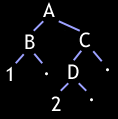

Here we've split the texture in half by line A then split the upper half by B and inserted the first lightmap to the left of B. When we go to insert the next one, we'll first check if it can fit above A and if it can we check to see if it can fit left of B, nope full, then right of B. If it fits there we split B exactly how we split the original texture, otherwise we insert and split below A. After inserting a second lightmap the texture becomes:


Pretty basic. The implementation of the tree is straightforward. Here it is in a C++ pseudocode hybrid:
struct Node
{
Node* child[2]
Rectangle rc
int imageID
}
Node* Node::Insert(const Image& img)
if we're not a leaf then
(try inserting into first child)
newNode = child[0]->Insert( img )
if newNode != NULL return newNode
(no room, insert into second)
return child[1]->Insert( img )
else
(if there's already a lightmap here, return)
if imageID != NULL return NULL
(if we're too small, return)
if img doesn't fit in pnode->rect
return NULL
(if we're just right, accept)
if img fits perfectly in pnode->rect
return pnode
(otherwise, gotta split this node and create some kids)
pnode->child[0] = new Node
pnode->child[1] = new Node
(decide which way to split)
dw = rc.width - img.width
dh = rc.height - img.height
if dw > dh then
child[0]->rect = Rectangle(rc.left, rc.top,
rc.left+width-1, rc.bottom)
child[1]->rect = Rectangle(rc.left+width, rc.top,
rc.right, rc.bottom)
else
child[0]->rect = Rectangle(rc.left, rc.top,
rc.right, rc.top+height-1)
child[1]->rect = Rectangle(rc.left, rc.top+height,
rc.right, rc.bottom)
(insert into first child we created)
return Insert( img, pnode->child[0] )
|
The insert function traverses the tree looking for a place to insert the lightmap. It returns the pointer of the node the lightmap can go into or null to say it can't fit. Note that you really don't have to store the rectangle for each node, really all you need is a split direction and coordinate like in a kd-tree, but it's more convenient with them.
The code that calls Insert can then use the rectangle from the returned node to figure out where to place the lightmap in the texture and then update the node's imageID to use as a handle for future use.
int32 TextureCache::Insert(const Image& img)
pnode = m_root->Insert(img)
if pnode != NULL
copy pixels over from img into pnode->rc part of texture
pnode->imageID = new handle
else
return INVALID_HANDLE
|
Once the lightmap is in the larger texture, you'll want to go through any meshes that use it and adjust their texture coordinates based on the lightmap's rectangle in the larger texture.
And now your moment of zen:


Pretty eh? These are some lightmaps from the Near Death Experience tech demo. I've padded each lightmap with white so you can see the separations. Other examples without padding.
Keep in mind that you can apply this same technique not just to lightmaps, but to packing any textures you want into larger ones. For example, the algorithm works like a charm for building font textures.
Anyhow, if you have any questions or comments email jimscott@blackpawn.com. Thanks for reading.